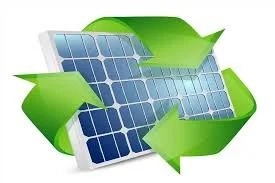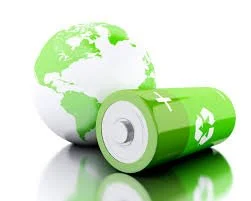RECYCLING USED SOLAR MODULES, WIND TURBINE BLADES & BATTERIES
Image courtesy of iStock
The Tiny Off Grid House will be designed to generate non-carbon energy exclusively from renewable energy sources using solar panels, a wind turbine and hydropower; along with battery storage. However, these renewable energy generating equipment are facing undeserved scrutiny from renewable energy skeptics and obviously the self-serving fossil fuel industry for environmental impacts; if any.
Critics of renewable energy propagate claims that photovoltaic (PV) panels, wind turbine blades and batteries can not be recycled; filling landfills at their end-of-life and polluting the environment. Any altruist concerns for the environment these critics may have should be equal to the harmful environmental impact of fossil fuels in all its carbon forms: crude oil, coal, natural gas (Methane) and unconventional shale gas.
PV panels, wind turbine blades and batteries can be recyclable and/or repurposed!
However, the efforts to recycle renewable energy generating equipment face the same economic obstacles as the plastic recycling industry faces. The technology to recycle these products are viable but have a low return on investment. In order to survive, the recycling industry requires government “recycling subsidies” just like the “subsidies” the agriculture industry receives. The exception is the battery recycling industry which already receives assistance from federal & state programs requiring battery suppliers to setup end of life product returns with financial incentives for consumers.
Lead-Acid batteries disposed in landfills can corrode and release Lead and Sulfuric Acid in to the environment and pollute drinking water sources. Recycling nickel-cadmium, small sealed Lead-Acid batteries and certain other rechargeable batteries have received a boost from U.S. Federal and State recycling regulations. The Federal Mercury Containing and Rechargeable Battery Act, known as The Battery Act, of May 13,1996, (Public Law 104 - 142, 104th Congress) requires, with certain exceptions, used Nickel-Cadmiun (NiCd) and small sealed Lead-Acid (Pb) batteries to be managed as Universal Waste (40 CFR Part 273). The Universal Waste Rule was created by the U.S. Environmental Protection Agency (EPA) and declares end-of-life Nickel-Cadmium and Lead-Acid batteries should not be disposed and must be recycled to reduce the amount of hazardous wastes entering the municipal solid waste stream.
Image courtesy of Li-Cycle
Companies like Li-Cycle, in Gilbert, Arizona, has a “95% recycling efficiency rate to return valuable commodity materials found in Lithium-ion batteries back to the supply chain.” Li-Cycle sustainable and work place safe methods use a proprietary hydrometallurgy process that does not require Oxygen; preventing any potential for a thermal event. A filter press is used to extract “Black Mass” containing Nickel (Ni), Cobalt (Co), Lithium (Li) . . .; including packaging materials such as plastics and vermiculate (Flame retardant). No smelting methods are used in the extraction process and water is used in a closed loop. Large, heavy, decommissioned EV batteries do not require manual dismantling and can be processed intact; increasing work place safety.
NOTE: According to the EPA “tape all battery terminals—with nonconductive tape—and/or place batteries in separate plastic bags and never put these batteries in household garbage or recycling bins.”
The U.S. State of Washington, Solar Stewardship Bill of 2017, enacted an end of life PV recycling program; while The New York State, Solar Collection Act, is pending. California 2015 SB489 designates end of life PV panels as universal waste which can not be landfilled. The European Union enacted laws for the end of life returns of PV panels for reuse or recycling.
The life expectancy of most modern PV panels are 25 - 30+ years; at 90% efficiency. The robust life expectancy mitigates its life cycle emissions rate and reduces the energy pay back time to an average of 4 years.
The increased use of PV panels will continue with the substantial rebates available from the Inflation Reduction Act of 2022 and economy of scale reducing manufacturing & installation costs. Besides federal & state incentives, extreme weather events caused by climate change is a motivating factor encouraging an investment in sustainable energy. Extreme heat events are raising the cost of electricity needed for home air conditioning. While Solar with battery backup allows for energy independence during grid down emergencies caused by extreme weather events.
A PV panel frame is made of Aluminum which is 100% recyclable infinitely without loosing its quality each time. The remaining recycled materials are 70% glass by weight, Silver which is 0.05% by weight, but 14% of total value, Silican, Glass, Copper and Cadmium.
Critics concerns of PV panels containing toxic metals that can harm the environment are exaggerated. Lead contained in PV panels are 1/10th below acceptable levels set by the U.S. Environmental Protection Agency (EPA). Cadmium levels are even lower.
Wind turbine blades are designed to be durable and operate in inclement weather conditions and surrounded by salt water for over 25+ years. Most wind turbines are prematurely decommissioned to install newer advanced models. Critics have been concerned about decommissioned wind turbine blades filling landfills; with no equal concern for the mass graves of car tires buried in landfills.
Most parts of wind turbines such as the metals, copper and concrete are recyclable. However, the turbine blades, made of composites, can be a challenge to recycling; but not insurmountable. The polymer resins tightly bond the fiber glass, carbon fibers and balsa wood to creating a permanent thermoset cross-linked durable, lite weight, flexible structure. Unlike recycling thermoplastic by untangling the links with heat to mold in to new shapes.
Some decommissioned wind turbine blades are repurposed in the production of lite-weight fiber reinforced materials used in the marine, automotive and aviation industry. Canvus, a company in Avon, Ohio, upcycles retired wind turbine blades in to furniture. While companies like Veolia shred decommissioned blades so the mass can be added to cement kilns to off-set the combustion of coal and limestone. The cement industry represents 8% of global greenhouse gas emissions.
Failure to recover valuable materials from renewable energy generating equipment perpetuates a cycle of resources depletion from the energy intensive process of mining & refining of raw materials for the production of new renewable energy generating equipment. This is not sustainable; only a closed loop lifespan from material extraction to final product and end-of-life recycling and/or repurposing can justify its renewable energy gains.
The 25 to 30+ years productive lifespan, with robust efficiency, of most solar panels and wind turbines mitigates their insignificant life cycle emissions rate. This is in comparison to combustion energy generating equipment with far less lifespans; more maintenance and greater environmental pollution.
Please share your thoughts or experiences in the Comments section below.

